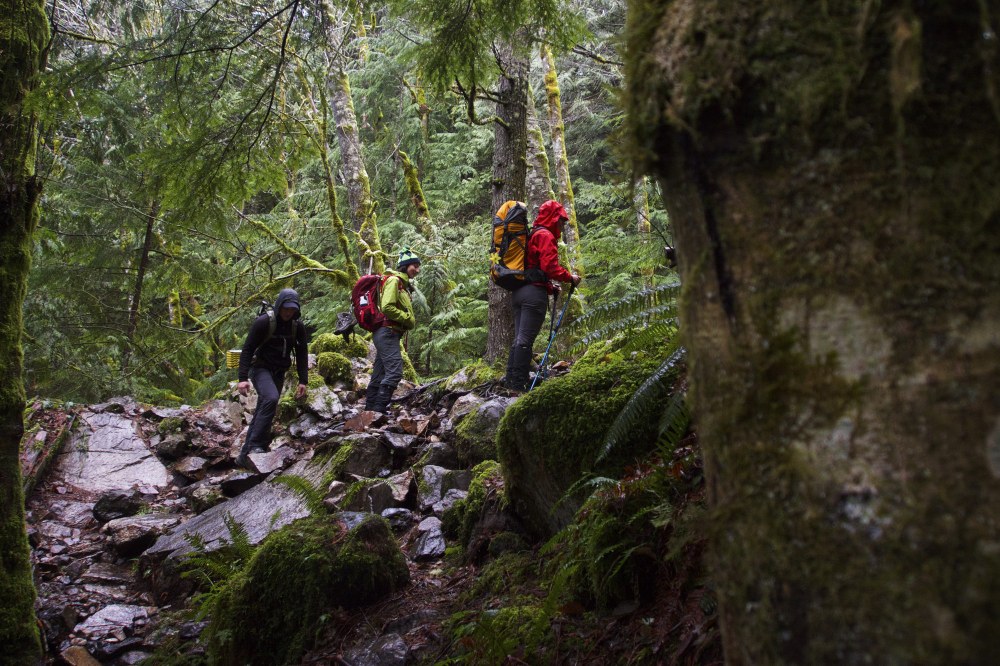
Hiking is a wonderful way to get outside, stretch your legs, and see the best of what the Northwest has to offer. However, it’s important to be mindful of the impacts that we can have on our public lands by doing our best to keep the places we visit wild and pristine.
Though it’s tempting to think one action won’t have a large impact, the volume of traffic we see on trails these days makes it more important than ever to be educated and enthusiastic about outdoor ethics. Understanding the role outdoor recreationists play as environmental stewards is key to keeping our trails clean, minimizing our impact on the environment, and respecting the wildlife that calls the area home.
The best way to reduce our impact is to practice Leave No Trace (LNT) ethics, a set of seven principles that summarize important behaviors for recreationists to practice. The seven principles of LNT are:
- Plan Ahead & Prepare
- Travel & Camp on Durable Surfaces
- Dispose of Waste Properly
- Leave What You Find
- Minimize Campfire Impacts
- Respect Wildlife
- Be Considerate of Other Visitors
To help new hikers understand and practice outdoor ethics, here are a few hiking-specific tips and tricks to make practicing LNT on the trail a breeze.
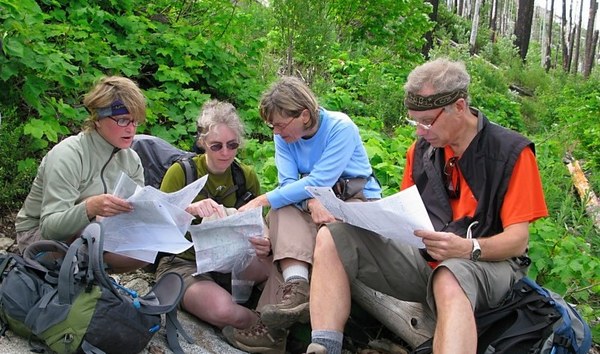 Hikers checking their maps.
Hikers checking their maps.
Plan Ahead and Prepare
Tip: Know Your Hike & Tell Others Where You Are
Getting lost could result in injury or the need for a search party, neither of which are happy outcomes after a day on the trail. Research your hike well before starting out, making a note of distance, elevation gain, weather, and trail conditions. Will the trail require route-finding skills? What’s your estimated trip time with few breaks? Is there a chance of rain? Will you have cell phone reception? These are all important questions to answer before you arrive at the trail head. Printing out or taking a screenshot of trail descriptions and trip reports is a great way to make sure you know what to expect before you arrive. Be sure to tell a friend or loved one where you are and when you expect to be back, to ensure that you have someone who can call the authorities if you do encounter an emergency.
Tip: Bring the Ten Essentials
The Ten Essentials is a comprehensive safety and packing list created by The Mountaineers in the 1970s, now a ubiquitous system used across the outdoor industry. Its purpose is to help recreationists avoid emergencies, and to be able to manage situations effectively if an emergency does indeed arise. It includes:
- Navigation
- Headlamp (plus extra batteries)
- Sun protection
- First aid
- Knife (plus repair kit)
- Fire
- Shelter
- Extra food
- Extra water
- Extra clothes
For a hiking-specific look at this list, take a look at our blog The Day Hiker’s Ten Essentials.
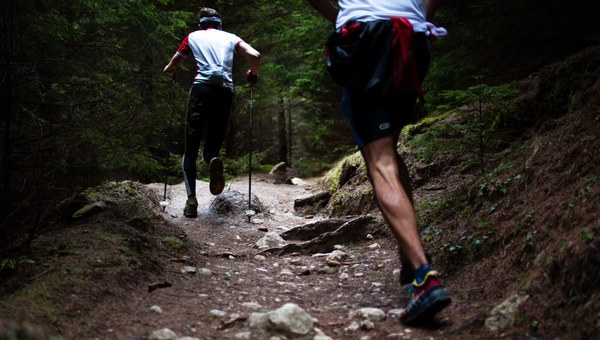 Trail runners on a wet day.
Trail runners on a wet day.
Travel and Camp on Durable Surfaces
Tip: Stay On-Trail - No Switchback Cutting!
Switchbacks may seem like a longer route to the summit of a hike, but they do much more than just help you pace your elevation gain. Trails that go straight up a hillside often become gullies as water rushes down the steep path in the rainy season and washes dirt away. Switchbacks are designed to avoid this issue while also making a trail more enjoyable to hike. Cutting switchbacks undermines these efforts and increases the area that sees foot traffic, resulting in a trail that is generally muddier, has less foliage, and sees more erosion from both foot traffic and water. It can also damage drainage diversions. This makes maintenance more challenging for volunteers and makes the trail less enjoyable for all users.
It’s key to avoid going off-trail even where switchbacks are not present, as it can damage plant life and encourage others to go off-trail as well. One small side trail created by a hiker can quickly become a popular path for many, expanding our impact on the surrounding land.
Tip: Step Through Mud, Not Around It
When heavy rains have left a trail wet and muddy, it is at its most vulnerable state and can erode far more easily than when the dirt is dry and compact. For this reason it’s important to step through shallow mud puddles whenever possible rather than stepping around them, which will erode and widen the trail. For this reason and many others, it’s important to be aware of the weather and trail conditions and to bring waterproof shoes if necessary.
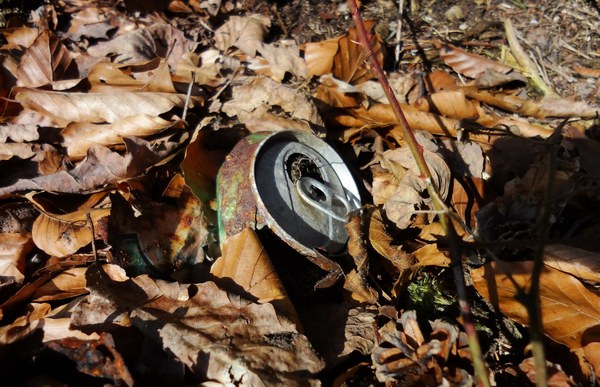 A piece of trash on-trail.
A piece of trash on-trail.
Dispose of Waste Properly
Tip: Don’t Leave Food Behind
Although it may be true that apple cores, banana peels, and sandwich crusts are all biodegradable, that doesn’t mean they won’t have a negative impact on the environment or animals when left behind. Banana peels can take up to two years to decompose, and other small bits of food attract animals that can become habituated to human behavior (potentially risking their safety and ours). The best way to avoid these issues is by ensuring food is never left behind on a hike. Do a visual sweep when you leave a break spot to ensure that no food or trash was forgotten.
Tip: Bring a Trash bag
Ziplock bags, grocery bags, or proper trash bags are all excellent trash receptacles when you’re on a hike. It’s important to bring a designated trash bag along to ensure that small pieces of wrappers or food don’t fall out of pockets or open bags. It’s also a great place to keep trash others have left on the trail.
Tip: Use the Bathroom Before you Go
Do you know if your hike has an operational bathroom at the trailhead? If not, do some research to make sure you know of a restroom near your hike, or use the bathroom before you leave the house. Human waste is becoming a major issue on many trails, and this is a sanitation issue not only for other hikers but for wildlife as well.
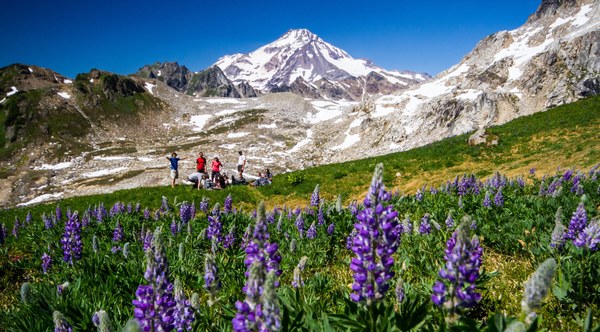 Wildflowers on Glacier Peak. Photo by Ida Vincent.
Wildflowers on Glacier Peak. Photo by Ida Vincent.
Leave What You Find
Tip: Bring Your Camera or Notebook
Although rocks or wildflowers are temping to take home with us, the volume of hikers we see on the trails means that we must all be diligent to leave our wild places as we found them. Bring a camera or a notebook to record what you see on your hike – it not only follows LNT ethics, but offers a memory that will last much longer than a flower (pro tip: use this as an opportunity to start your own nature journal).
Tip: Don’t Create Rock Stacks (Cairns)
Rock stacks are becoming increasingly common on many popular trails due to their appearance on social media. Rock stacks (known as cairns) should only be located on trails that require route-finding skills, as their purpose is to identify the correct path. Inappropriately located cairns can lead hikers off the correct path and remove rocks from the surrounding environment. Lessen your impact on the trail around you and refrain from creating cairns.
 A chipmunk having a snack in the Enchantments. Photo by Ida Vincent.
A chipmunk having a snack in the Enchantments. Photo by Ida Vincent.
Respect Wildlife
Tip: Keep Your Distance From Animals & Never Feed Them
Curious chipmunks are a common site at many lunch spots in the mountains, but it’s important that we remember the dangers of animal habituation and do our best to avoid them. Habituation is when an animal loses its fear of humans due to repeated exposure, and often happens when an animal associates humans with food. Impacts can include altered foraging behaviors, increased vulnerability to predation, and aggressive behavior toward humans. We can avoid these issues by being mindful of food scraps, keeping our distance from animals, and discouraging animals who get too close. “A fed animals is a dead animal” is a common refrain in the outdoors, and it’s important that we protect the creatures whose homes we visit.
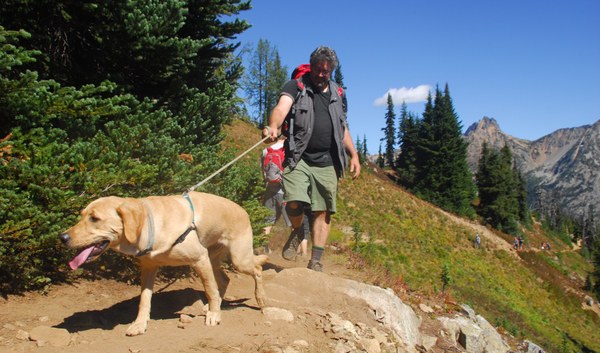 A lab hiking along Maple Loop Pass. Photo by Tom O'Keefe.
A lab hiking along Maple Loop Pass. Photo by Tom O'Keefe.
Be Considerate of Other Visitors
Tip: Bring Headphones, Not Speakers
Many people access our public lands to find solace in nature, and it’s important that we respect the experience of all by avoiding artificial noise on the trail. Though speaker use is fun and appropriate for a group setting in many local parks, on trails they can be disruptive to both fellow hikers and animals in the area. Help keep our wild places feeling wild by bringing headphones on your next hike.
Tip: Yield to Uphill Hikers
Much like our roads, trails have an etiquette designed to help keep traffic moving smoothly. Hikers should always yield to those traveling uphill (or toward the destination), as those on an incline may have a smaller field of vision and may be pacing themselves up the trail. Uphill hikers may step aside for a breather and yield to downhill hikers, but that ought to be determined by the uphill hiker. If you have to step off the trail to yield, do your best to stand somewhere that won’t damage plant life or switchbacks.
Tip: Stay in Single File
Going on a hike with a large group of friends and family can be a lot of fun, but it’s important to stay in single file whenever possible to avoid traffic jams on the trail. This will also make yielding to uphill hikers easier and avoid erosion on narrow trails.
Tip: Bring a Leash if Your Dog Comes Along
There are a lot of wonderful dog-friendly trails in the area, but that doesn’t mean we can let our canine friends off-leash. Plants, animals, hikers, and other dogs all pose potential distractions and can result in a lost dog or dangerous situations. Even though it may be easier to keep a dog off-leash, it’s important to respect other trail users and use a leash so that dog-friendly trails may remain that way. See our Hiking With Dogs blog for more information on how to get outside with your dog.
Extra Credit
Low Impact Recreation Skills
If you’d like to learn more about LNT ethics and how to be a responsible outdoor recreationist, check out our Low Impact Recreation Skills videos. We cover everything from hiking to using the bathroom in the backcountry.
Advocate for Our Public Lands
Understanding how we can advocate for our lands is a key way to protecting the places where we play for generations to come. In our free Protecting Public Lands 101 eLearning course, we’ll break down the basics of our national public lands system, and how you can step up to protect the outdoor experience. Topics include: primary land management agencies, conservation designations, conservation laws, and how to take action.
Other hiking blogs:
- Day Hiking 101
- Know Before You Go: Your First Mountaineers Hike
- Hiking With Dogs – The Basics
- How To: Build Your Own Conditioning Hiking Series
Lead image of hikers ascending Mt. Teneriffe. Photo by Rafael Godoi.
Add a comment
Log in to add comments.Leave No trace is the best Tip for New Hikers.
Not just search for your Happiness and Adventure, Care for Nature too.
 The Mountaineers
The Mountaineers